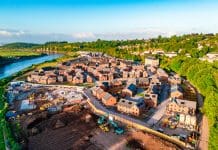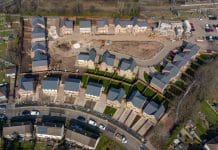With the country in the grip of a housing shortage, combined with the Government’s target of building 200,000 new homes each year, brownfield sites have unsurprisingly become increasingly popular for development ventures in recent years.
And with ground conditions for brownfield sites fundamental to the success of a development, a good understanding of the risks and liabilities associated with the subsurface is essential to ensure the scheme is viable and that profit margins are safeguarded.
In this article, Alex Egan, Technical Director at ESI Ltd – one of the UK’s leading independent scientific environmental consultancies – explores some of the environmental issues to take into consideration when building on a brownfield site, and why it’s so important to consult the experts before a project commences.
“There are a number of benefits when it comes to building on brownfield sites – not only does it improve our environment by addressing potential health hazards and eyesores, but it is a catalyst for community and commercial regeneration.
The real barrier to development on brownfield land, however, is often the abnormal ground conditions and the associated risks to budget and cash flow for developers. This is particularly important in areas where the land values are depressed and it’s difficult for developers to see the risks justifying the potential rewards.
The financial challenge for many developers is often the time and expense associated with simply getting to a point where the ground risks and other fundamental constraints are well enough understood to make an informed gamble on the viability of development. And, with the complex interaction of natural and man-made matters affecting land condition, its chemical sustainability and its ability to suitably support foundations, it is imperative that brownfield sites are properly investigated and assessed before redevelopment takes place.
Such assessments can highlight a range of issues, from relatively minor risks right through to major problems that could cause structural failure, pollution of the environment, or serious health hazards to both construction workers and future occupants of the development. This in turn poses a series of potential ownership liabilities under both contaminated land and health and safety legislation, as well as a significant cost and programme risk to the development, with a number of complex and inter-related barriers to economically bring brownfield land back into beneficial use.
Land contamination is a significant issue that can affect the building process, and across the UK there are a large number of sites contaminated through previous use, such as industrial processes, mining, and waste disposal. Even if they’ve ceased operation, waste materials and residues can still be present in the land and groundwater. For the vast majority of brownfield sites, the planning process is used by regulators as a tool to bring such sites back to a standard that does not pose undue risk to the environment, and suitable for use under the chosen development form.
Soils, groundwater and soil gases should all be thoroughly investigated and assessed on brownfield sites as they can impact construction workers, future site users, buildings, and the wider environment. In addition, and something that is often overlooked, is the potential cost implications of the disposal of contaminated soils from development sites, as this can often lead to substantial punitive costs if not identified and managed from an early stage through design.
Ground stability and strength is another matter that must be explored before a redevelopment project gets underway. Geotechnical risks that can arise include anything from unstable or weak ground to mining and sinkholes, and could pose a major risk to the building and its stability. The degree to which ground improvement is needed and the type of foundations required are often key cost considerations in determining the feasibility of development on difficult sites.
In addition, flooding and drainage is often a great concern for developers and regulators alike, and a Flood Risk Assessment is required for any planning application where a site is defined by published mapping to be at risk. Considerations here are twofold, and developers should take into account both the risk to the site from flooding, and the risk that development of the site may have in causing flooding elsewhere. Increasingly it is the case that these issues are intrinsically linked, and a detailed understanding of their interrelationship, and their implications on the form and commercial elements of a development are key to overall viability.
An effective balancing of cost and risk is therefore of paramount importance in guiding the developer through from project inception to build. With viability at the heart of the issue, investing carefully and proportionally in a programme of staged investigation is key in order to limit upfront spend at a time when commercial, political, and planning matters may render such outlay speculative. A valuable – but often overlooked – skill in providing advice on ground conditions is therefore the ability to tailor the investigation and assessment of such issues in order to focus on matters pertinent to each point in a project cycle.
A competent and experienced geo-environmental organisation – like ESI Ltd – can provide clear and pragmatic advice and essentially assist in ensuring safe, compliant, and above all, cost effective development. Such advice is best sought at project inception, as obtaining expert guidance at this stage will enable early characterisation of risk and liabilities, and will maximise the ability to review options early in the development process, hence maximising opportunity.” ESI’s property team can support you with:
- Rapid liability assessments;
- Phase 1 Desk Studies;
- Phase 2 Site geo-environmental investigations;
- Geotechnical assessments;
- Monetised risk assessments;
- Remediation options and strategies;
- Flooding and drainage;
- Regulator negotiation.
Founded in 1996, ESI provides a broad range of geo-environmental services, from early stage due diligence advice and desk study reporting to large scale intrusive investigation assessment and remediation. The firm’s reports deliver clear, pragmatic and expert advice to the property industry, and assist in ensuring safe, compliant and cost-effective land sales and development. The consultancy team comprises some of the most experienced and talented in the industry, and has a proven track record and reputation for supporting many of the UK’s leading developers, land owners and property professionals with the ground and flood-risk aspects of land sale, purchase and development. As an independent consultancy, ESI is able to form flexible and commercial relationships with other specialist organisations who also strive for excellence, which in-turn ensures its clients receive the very best advice and service.
For further information, please call 01743 276 100, email info@esinternational.com, or visit www.esinternational.com .
Alex Egan
Technical Director
ESI Ltd
Tel: +44 1743 276100
info@esinternational.com













